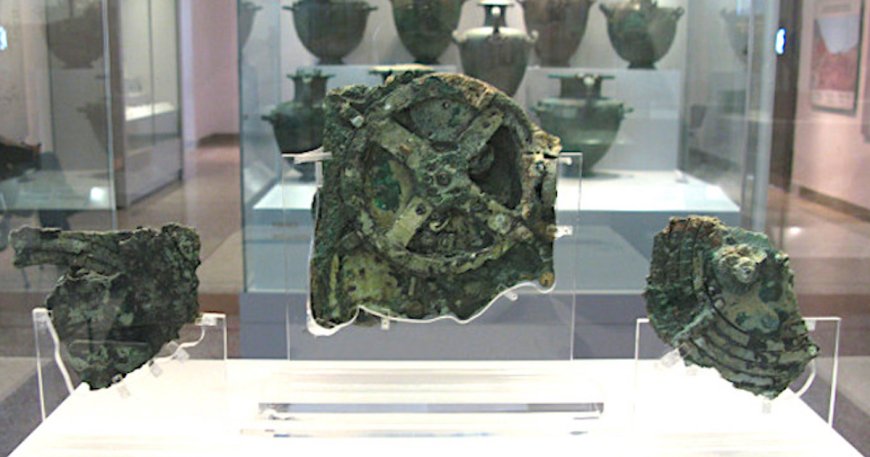The Antikythera Mechanism: The World’s First Analog Computer and Its Mysterious Creators
The Antikythera Mechanism is the world’s first analog computer, built over 2,000 years ago. Discover its mysterious origins and advanced astronomical functions.

Over 2,000 years ago, an ancient shipwreck off the coast of Greece hid one of the most astonishing technological discoveries in history—the Antikythera Mechanism. Often called the world’s first analog computer, this intricate device was centuries ahead of its time, capable of tracking celestial movements, predicting eclipses, and even organizing ancient Greek sporting events.
But who built it? How did they develop such advanced engineering long before the modern era? The true origins of the Antikythera Mechanism remain one of history’s greatest mysteries.
Discovery of the Antikythera Mechanism
In 1901, sponge divers exploring a shipwreck near the island of Antikythera (between Crete and mainland Greece) uncovered a corroded bronze artifact that initially went unnoticed. However, as archaeologists studied it further, they realized it contained a complex system of interlocking gears, unlike anything seen from the ancient world.
Over the decades, researchers painstakingly analyzed the mechanism, using X-ray scans and computer models to understand its function. What they found was astonishing:
- The device consisted of more than 30 precision gears.
- It could predict solar and lunar eclipses years in advance.
- It tracked the movements of the five known planets of the time.
- It calculated the timing of Olympic Games and other Greek festivals.
How the Antikythera Mechanism Worked
The Antikythera Mechanism functioned like a mechanical universe. By turning a hand-crank, the user could simulate the movement of the Sun, Moon, and planets, displaying astronomical cycles on rotating dials.
Key features included:
- Zodiac and Calendar Dials – Showed the position of celestial bodies relative to constellations.
- Eclipse Prediction Dial – Used a 223-month Saros cycle to forecast eclipses.
- Lunar Phase Indicator – Accurately represented the changing shape of the Moon.
- Olympic Games Dial – Marked the schedule of ancient Greek sporting events.
This level of precision suggests that ancient engineers had an incredible understanding of astronomy and mathematics.
Who Built the Antikythera Mechanism?
The identity of its creators remains unknown, but historians speculate that it may have been developed by Greek scientists and mathematicians. Some key theories include:
- Archimedes (287–212 BCE) – The famous Greek mathematician was known for designing intricate mechanical devices. Some believe his ideas may have influenced the mechanism.
- Hipparchus (c. 190–120 BCE) – An astronomer who made groundbreaking calculations about the Moon’s orbit. His work aligns closely with the mechanism’s design.
- Workshops in Rhodes or Alexandria – These cities were ancient hubs of learning, known for producing complex astronomical devices.
Why Was the Technology Lost?
Despite its advanced design, no similar devices were found from the ancient world. Some reasons why this technology may have been lost include:
✔ The Fall of Ancient Greece and Rome – As civilizations declined, scientific knowledge was lost or forgotten.
✔ Devices Made of Perishable Materials – If similar mechanisms were built using wood or weaker metals, they wouldn’t have survived over time.
✔ Secret Knowledge of Elite Scholars – Advanced engineering may have been limited to small scientific circles, preventing widespread use.
The Antikythera Mechanism’s Legacy
Today, the Antikythera Mechanism challenges our assumptions about ancient technology. It proves that advanced mechanical engineering existed long before the Renaissance.
Modern scientists have even recreated working models of the device, confirming its accuracy. It remains one of the greatest unsolved mysteries of the ancient world—an astonishing glimpse into the forgotten genius of early civilizations.
Could more devices like this still be hidden beneath the sea, waiting to be discovered?
What's Your Reaction?
 Like
0
Like
0
 Dislike
0
Dislike
0
 Love
0
Love
0
 Funny
0
Funny
0
 Angry
0
Angry
0
 Sad
0
Sad
0
 Wow
0
Wow
0



















































